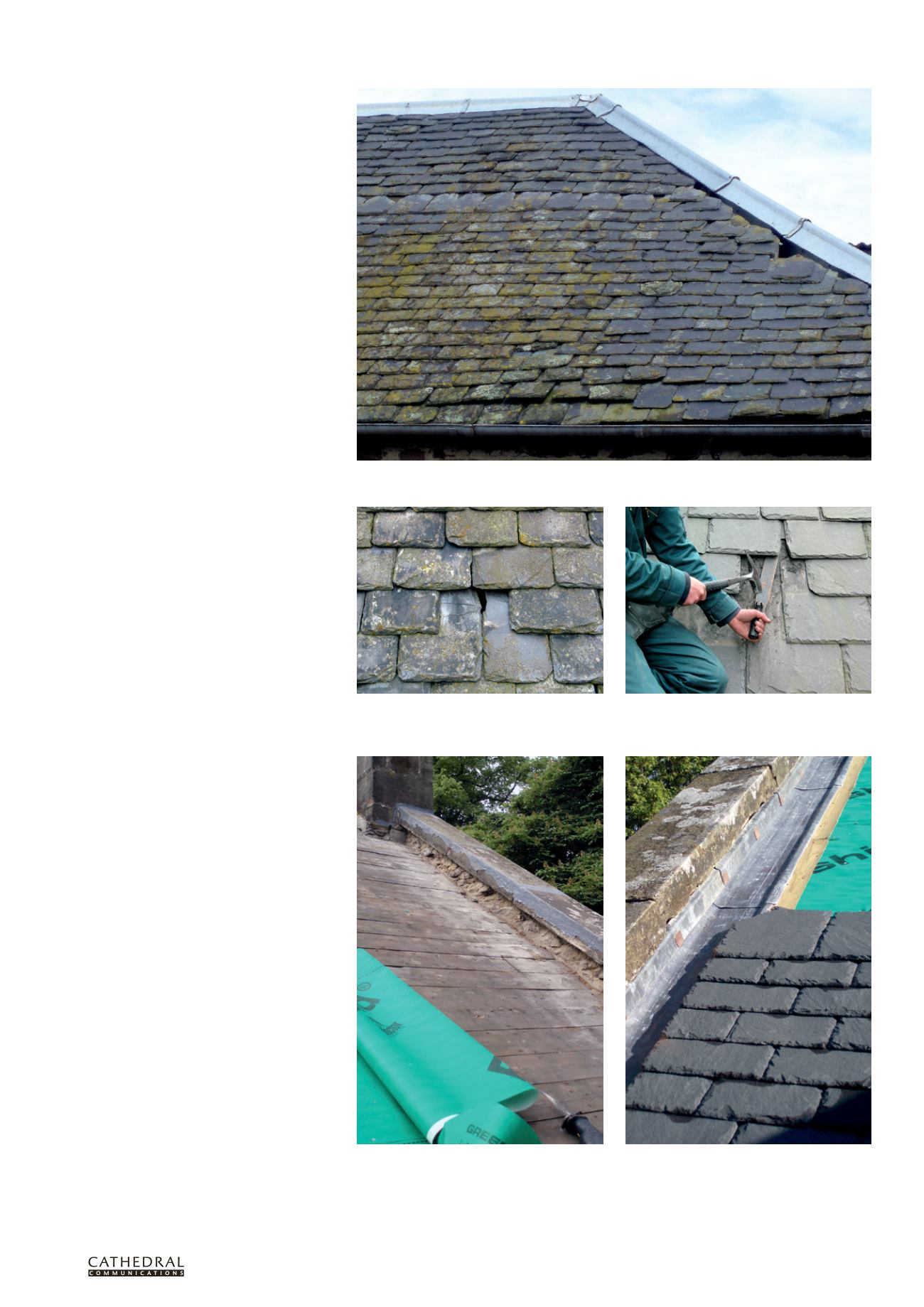

T W E N T Y S E C O N D E D I T I O N
T H E B U I L D I N G C O N S E R VAT I O N D I R E C T O R Y 2 0 1 5
8 3
3.1
STRUCTURE & FABR I C :
ROOF I NG
decreasing to under 50mm at the top of the roof
to allow the smaller slates to lie properly.
The varying widths of slate mean that an
even side lap cannot always be maintained.
(The side lap is the distance between the
edge of a slate and the edge of the slate which
it partially covers in the course below.)
Generally the side lap is worked out by placing
the perpendicular joint between two slates in
a course approximately centrally to the slate in
the course below. In practice, this is difficult
to maintain with slates of varying sizes so it
is usually assumed that the side lap will be at
least 50mm. One and a half slates are often
used on the edges of the slopes, while narrow
bachelor or ‘in-bands’ slates are used mid-row
to regulate the side lap.
Slates should be single nailed as in
traditional practice. Fixing with non-ferrous
nails is likely to prove more durable in
the long term and copper nails are often
specified. Traditionally it was usual to
‘cheek nail’ (or side nail) every sixth course
to help keep slates in place and T-shaped
nails were manufactured specifically for
this purpose. In exposed areas or on turrets
this can be increased to every three courses.
This practice is likely to be beneficial
in repair work. In some cases slates in
exposed areas are bedded in mortar to keep
them in place, particularly when working
with smaller sizes nearer the ridge.
REPAIR OF LEADWORK ON
SCOTTISH SLATE ROOFS
The correct repair of leadwork is a subject
in its own right but it in the context of slate
roofs it is an important part of the works
and should always be done at the same
time. As mentioned, lead is often used in
situations such as valleys and at points where
masonry such as parapets and chimneys
meets slate roofs. Where such leadwork
is being repaired it is important that it is
correctly detailed and secured and that lead
of a sufficient thickness (or ‘code’) is used
to ensure a durable repair. For example,
Code 7 lead is recommended for valleys.
Relevant trade association guidance
should be consulted and Scottish practice
in this area followed when repairs are being
carried out. On many traditional roofs mortar
skews were used, and while their replacement
with lead is likely to result in a more durable
repair, the change in material, and the
angles in which the slates sit will change the
appearance of the roof (Figure 11).
RIDGES
The ridges of slate roofs are an area of
vulnerability and are treated in a number of
ways. Lead is often employed along ridges,
applied over a timber former called a ridge
roll. Where cost is an issue zinc ridge of
standard length can be used. In some cases
ridges are formed of terracotta or stone. Any
repair or replacement should be carried out
using like-for-like materials to ensure that
the visual integrity of the roof is maintained.
Whatever material is used it is important to
ensure a firm fixing or bed to aid the securing
of the smaller slates at the top of the roof.
Figure 8 Individual missing slates can be patch-
repaired fairly easily using single nailing. The double
lap characteristic of Scottish roofs is also evident.
Figure 9 Removing the head of a broken slate using a
slate ripper
Figure 10 These sarking boards are in sufficiently
good condition for replacement slates to be laid onto
them with the addition of a breathable membrane.
(Photo: WD Cameron Slaters)
Figure 11 Lead detail at a gable parapet
(or ‘skew’) installed during re-slating work
(Photo: WD Cameron Slaters)
Figure 7 Where a roof has suffered the loss of many slates and is showing signs of further deterioration,
re-slating is likely to be required.
















